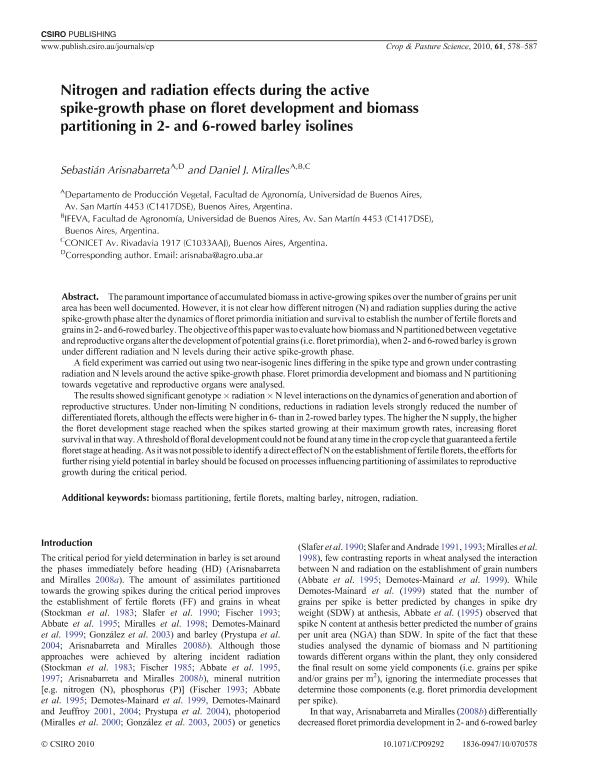Artículo
Nitrogen and radiation effects during the active spike-growth phase on floret development and biomass partitioning in 2- and 6-rowed barley isolines
Fecha de publicación:
10/2010
Editorial:
Csiro Publishing
Revista:
Crop and Pasture Science
ISSN:
1836-0947
Idioma:
Inglés
Tipo de recurso:
Artículo publicado
Clasificación temática:
Resumen
The paramount importance of accumulated biomass in active-growing spikes over the number of grains per unit area has been well documented. However, it is not clear how different nitrogen (N) and radiation supplies during the active spike-growth phase alter the dynamics of floret primordia initiation and survival to establish the number of fertile florets and grains in 2- and 6-rowed barley. The objective of this paper was to evaluate how biomass and N partitioned between vegetative and reproductive organs alter the development of potential grains (i.e. floret primordia), when 2- and 6-rowed barley is grown under different radiation and N levels during their active spike-growth phase. A field experiment was carried out using two near-isogenic lines differing in the spike type and grown under contrasting radiation and N levels around the active spike-growth phase. Floret primordia development and biomass and N partitioning towards vegetative and reproductive organs were analysed. The results showed significant genotype ×radiation ×N level interactions on the dynamics of generation and abortion of reproductive structures. Under non-limiting N conditions, reductions in radiation levels strongly reduced the number of differentiated florets, although the effects were higher in 6- than in 2-rowed barley types. The higher the N supply, the higher the floret development stage reached when the spikes started growing at their maximum growth rates, increasing floret survival in that way. A threshold of floral development could not be found at any time in the crop cycle that guaranteed a fertile floret stage at heading. As it was not possible to identify a direct effect of N on the establishment of fertile florets, the efforts for further rising yield potential in barley should be focused on processes influencing partitioning of assimilates to reproductive growth during the critical period.
Palabras clave:
Biomass Partitioning
,
Fertile Florets
,
Malting Barley
,
Nitrogen
,
Radiation
Archivos asociados
Licencia
Identificadores
Colecciones
Articulos(IFEVA)
Articulos de INST.D/INV.FISIOLOGICAS Y ECO.VINCULADAS A L/AGRIC
Articulos de INST.D/INV.FISIOLOGICAS Y ECO.VINCULADAS A L/AGRIC
Citación
Arisnabarreta Dupuy, Sebastián; Miralles, Daniel Julio; Nitrogen and radiation effects during the active spike-growth phase on floret development and biomass partitioning in 2- and 6-rowed barley isolines; Csiro Publishing; Crop and Pasture Science; 61; 7; 10-2010; 578-587
Compartir
Altmétricas




